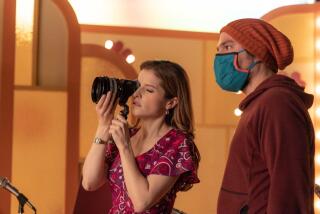‘Hancock’
- Share via
WHERE IS it written that superheroes have to be selfless? What would happen if an individual with supernatural powers was surly, self-absorbed and acid-tongued? Would he still be a hero? Would people still want him around?
“Hancock,” the new Will Smith vehicle, asks those smart questions, but after initial moments of success its answers get dumb and dumber. It’s a strange feeling to see the summer’s most promising premise self-destruct into something bizarre and unsatisfying, but that is the “Hancock” experience.
Probably no one but Smith, possibly the most likable actor in the world, could have breathed the right kind of life into this unusual character, first met sleeping off a monumental binge on a bench in Los Angeles.
Being hung over, we soon learn, is business as usual for Hancock, a superhero who hangs out in dive bars, drinks from the bottle and wears ragged clothes and a wool cap that has seen better days.
Yes, Hancock has all of Superman’s talents -- he is ridiculously strong, invulnerable and able to to leap tall buildings in a single bound -- but because he is often drunk and/or hung over when the call to action comes, he causes as much trouble as he prevents.
When Hancock stops a car full of gun-toting gangbangers, he destroys assorted vehicles and a freeway sign and defaces a local monument in the process. When he tosses a beached whale back into the ocean, he capsizes a boat. Hancock is clearly the guy the term “collateral damage” was invented for.
Worse than that, Hancock has a blistering tongue, something the film’s trailers have taken care to avoid revealing. That a film with dauntingly profane diatribes that would make a stevedore blush got a PG-13 rating, while the much sweeter “Election” was saddled with an R a few years back, will be catnip to those who think the MPAA ratings board (which reportedly twice gave “Hancock” an R before further cuts changed its mind) invariably gives away the store to major studio releases.
Things might have gone on like this forever for Hancock -- who knows how long a superhero’s liver can hold out -- if he hadn’t one day saved the life of a man named Ray Embrey (an agreeable Jason Bateman), whose car was trapped on railroad tracks with a train bearing down. Embrey turns out to be a good-natured public relations man who believes in making the world a better place and specializes in image consulting. Though his wife Mary (an initially underutilized Charlize Theron) takes a visceral dislike to Hancock, Embrey decides nothing will do but that he will help this reluctant superhero to clean up his act.
Some of this stuff, like training Hancock to ask politely before rescuing someone and to say “good job” even when people are not doing one, is amusing. But when Hancock agrees to go to jail for the damage he’s caused, the result is an anatomically challenging encounter with a pair of inmates that makes an even further mockery, if that’s possible, of the film’s puny rating.
As written by Vy Vincent Ngo and Vince Gilligan and directed by Peter Berg, “Hancock” up to this point takes misanthropic glee in its deconstruction of the conventions of superheroism. It’s abrasive as all get out, but Smith’s charisma and the cleverness of the concept keep us in the picture.
But then, just about without warning, “Hancock” makes a completely unexpected and head-shaking plot turn that derails the film in a way that it never recovers from. This second part of “Hancock” has the further disadvantage of coming up with its convoluted rules as it goes along, making it especially hard to understand what is happening to its characters or the reasons for its events.
Theron has more prominence as things progress, and, also out of nowhere, gives one of her strongest performances. But this part of the film also reveals a weakness for standard-issue violence and savagery that comes from a much more conventional place than the film’s initial concept.
The creators of “Hancock” truly had a tiger by the tail with their primary idea, and once they let go, the beast turned around and swallowed them whole. This is Hollywood, after all, a town without pity. Or, for that matter, anything resembling good common sense.
“Hancock.” MPAA rating: PG-13 for some intense sequences of sci-fi action and violence, and language. Running time: 1 hour, 32 minutes. In general release.
More to Read
The biggest entertainment stories
Get our big stories about Hollywood, film, television, music, arts, culture and more right in your inbox as soon as they publish.
You may occasionally receive promotional content from the Los Angeles Times.










